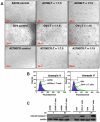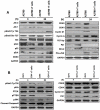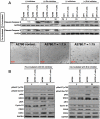Human ovarian tumor cells escape γδ T cell recognition partly by down regulating surface expression of MICA and limiting cell cycle related molecules
- PMID: 21935360
- PMCID: PMC3173356
- DOI: 10.1371/journal.pone.0023348
Human ovarian tumor cells escape γδ T cell recognition partly by down regulating surface expression of MICA and limiting cell cycle related molecules
Abstract
Background: Mechanisms of human Vγ2Vδ2 T cell-mediated tumor immunity have yet to be fully elucidated.
Methods and findings: At least some tumor cell recognition is mediated by NKG2D-MICA interactions. Herein, by using MTT assay and PI-BrdU co-staining and Western-blot, we show that these Vγ2Vδ2 T cells can limit the proliferation of ovarian tumor cells by down regulation of apoptosis and cell cycle related molecules in tumor cells. Cell-to-cell contact is critical. γδ T cell-resistant, but not susceptible ovarian tumor cells escape γδ T cell-mediated immune recognition by up-regulating pErk1/2, thereby decreasing surface MICA levels. Erk1/2 inhibitor pretreatment or incubation prevents this MICA decrease, while up-regulating key cell cycle related molecules such as CDK2, CDK4 and Cyclin D1, as well as apoptosis related molecules making resistant tumor cells now vulnerable to γδ T cell-mediated lysis.
Conclusion: These findings demonstrate novel effects of γδT cells on ovarian tumor cells.
Conflict of interest statement
Figures







References
-
- Porcelli S, Brenner MB, Band H. Biology of the human gamma delta T-cell receptor. Immunol Rev. 1991;120:137–183. - PubMed
-
- Morita CT, Parker CM, Brenner MB, Band H. TCR usage and functional capabilities of human gamma delta T cells at birth. J Immunol. 1994;153:3979–3988. - PubMed
-
- Bukowski JF, Morita CT, Brenner MB. Human gamma delta T cells recognize alkylamines derived from microbes, edible plants, and tea: implications for innate immunity. Immunity. 1999;11:57–65. - PubMed
-
- Morita CT, Jin CG, Sarikonda G, Wang H. Nonpeptide antigens, presentation mechanisms, and immunological memory of human V gamma 2 V delta 2 T cells: discriminating friend from foe through the recognition of prenyl pyrophosphate antigens. Immunological Reviews. 2007;215:59–76. - PubMed
Publication types
MeSH terms
Substances
Grants and funding
LinkOut - more resources
Full Text Sources
Medical
Research Materials
Miscellaneous

